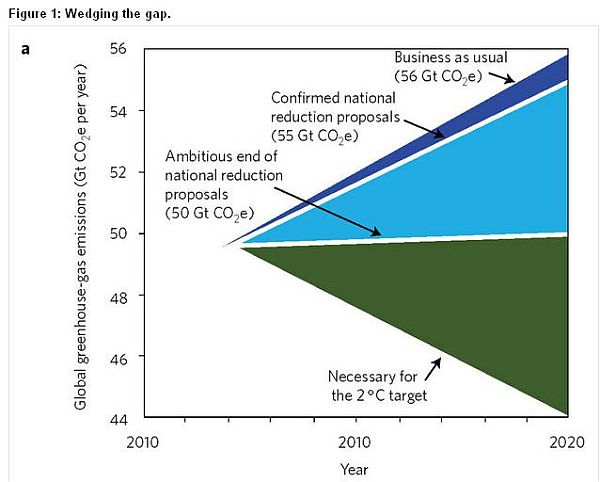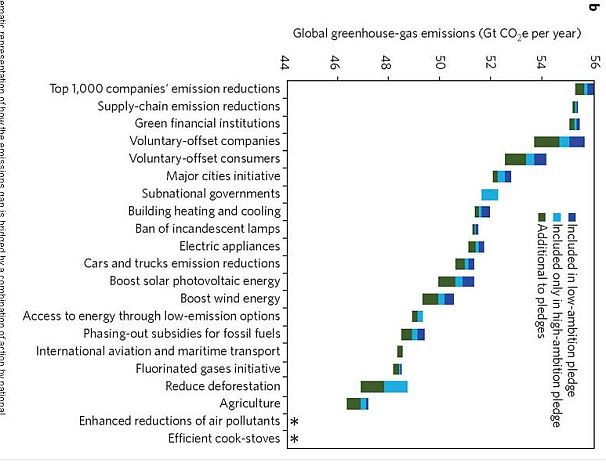In the past, whenever world leaders have huddled to discuss what to do about this steadily warming planet of ours, they’ve usually endorsed one big, sweeping solution. That was the logic behind the Kyoto Protocol — each nation would promise sharp cuts in their overall carbon emissions.
That hasn’t worked so far. Global emissions are still rising rapidly. That’s why, in a new paper for Nature Climate Change, four researchers take a different approach. Instead of starting with one large, overarching carbon limit dreamed up at U.N. conferences, they argue that countries and cities and companies should take 21 different energy measures that they’re already doing and scale them up. Large corporations are already pledging to clean up their supply chains. Nations are already setting fuel-efficiency standards. And so on. If each of these small measures could just be strengthened, the authors argue, the world might be able to meet its climate goals after all.
Let’s start with the dilemma. Various world leaders have decided, after considering the scientific evidence, that it would be rash and risky to let the world warm more than 2°C (3.6°F) above pre-industrial levels. (See here for a primer on why.) But if you add up all of the actual promises by national governments to cut emissions so far, even their most ambitious ones, we’re still very far from the cuts necessary to stay under 2°C. Here’s a chart showing the “emissions gap”:
So how could the world close the gap? How would we get from that light-blue triangle to the green one? One way is for world leaders to keep promising, at various U.N. conferences, that they’ll pursue ever more ambitious goals. But that hasn’t worked well to date. So in the Nature Climate Change paper, “Bridging the greenhouse-gas emissions gap,” the authors identify 21 smaller policies that could add up to get the world under that green triangle by 2020. Here’s the graph:
What are these policies? To some extent, they’re things that people are already doing. Many of the 1,000 largest greenhouse gas emitters in the world have already pledged to reduce their emissions through money-saving efficiency measures. If an organization like the World Business Council could somehow lead just 30 percent of these companies to cut their energy emissions 10 percent by 2020, that would add a significant chunk of the needed cuts. Another chunk of cuts could come from companies like Wal-Mart that have pledged to “clean up” their supply chains.
Likewise, the world could get more emissions chunks if all of the hundreds of cities that have pledged to cut emissions around the world actually followed through on their promises. Another chunk could come if governments continued to pursue policies like making buildings and appliances more energy-efficient, boosting the fuel-economy of automobiles, and phasing out incandescent light bulbs. Existing initiatives to stop deforestation, clean up the shipping and aviation sectors, and eliminating fluorinated gases could add another big chunk.
Add up all 21 of these chunks, the authors note, and the world would close the emissions gap by 2020 — going well beyond what world leaders have already promised. And they wouldn’t need another Kyoto Protocol to do it.
But is this at all realistic? The authors, Kornelis Blok, Niklas Höhne, Kees van der Leun and Nicholas Harrison, note that there’s a serious coordination problem here. It’s not just national governments that are acting here. Companies, mayors, and regional governors would all need to play a role. And that leads to a serious collective action problem. “Even individual actions by large companies or big cities,” the authors note, “will rarely have an impact of more than a few megatonnes of carbon dioxide equivalent.” Someone will have to figure out how to coordinate all these different efforts. That could prove even more difficult than wrangling a bunch of national governments to agree on emissions targets.
That said, it’s not clear that there’s a stunningly effective alternative on the table right now. In a rather scathing recent post, Doug Boucher of the Union of Concerned Scientists argues that the ongoing climate negotiations between diplomats at the Earth Summit in Rio de Janeiro are likely to be just as pointless as they have been at international conferences over the next five years. At the very least, the Nature Climate Change paper offers a different way to look at how the world could possibly meet its global-warming goals between now and 2020.


